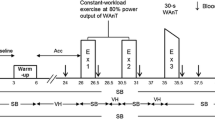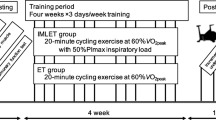Abstract
Purpose
Hyperventilation, implemented during recovery of repeated maximal sprints, has been shown to attenuate performance decrement. This study evaluated the effects of hyperventilation, using strength exercises, on muscle torque output and EMG amplitude.
Methods
Fifteen power-trained athletes underwent maximal isokinetic knee extensions consisting of 12 repetitions × 8 sets at 60°/s and 25 repetitions × 8 sets at 300°/s. The inter-set interval was 40 s for both speeds. For the control condition, subjects breathed spontaneously during the interval period. For the hyperventilation condition, subjects hyperventilated for 30 s before each exercise set (50 breaths/min, PETCO2: 20–25 mmHg). EMG was recorded from the vastus medialis and lateralis muscles to calculate the mean amplitude for each contraction.
Results
Hyperventilation increased blood pH by 0.065–0.081 and lowered PCO2 by 8.3–10.3 mmHg from the control values (P < 0.001). Peak torque declined with repetition and set numbers for both speeds (P < 0.001), but the declining patterns were similar between conditions. A significant, but small enhancement in peak torque was observed with hyperventilation at 60°/s during the initial repetition phase of the first (P = 0.032) and fourth sets (P = 0.040). EMG amplitude also declined with set number (P < 0.001) for both speeds and muscles, which was, however, not attenuated by hyperventilation.
Conclusion
Despite a minor ergogenic effect in peak torque at 60°/s, hyperventilation was not effective in attenuating the decrement in torque output at 300°/s and decrement in EMG amplitude at both speeds during repeated sets of maximal isokinetic knee extensions.




Similar content being viewed by others
Abbreviations
- AMPnorm :
-
Normalized EMG amplitude
- ANOVA:
-
Analysis of variance
- EMG:
-
Electromyography/electromyogram
- [La−]:
-
Blood lactate concentration
- NaHCO3 :
-
Sodium bicarbonate
- PCO2 :
-
Partial pressure of carbon dioxide (blood)
- PCr:
-
Creatine phosphate
- PETCO2 :
-
End-tidal partial pressure of carbon dioxide (expired air)
- RR:
-
Respiratory rate
- \( {\dot{V}}E \) :
-
Minute ventilation
- VL:
-
Vastus lateralis muscle
- VM:
-
Vastus medialis muscle
- VT:
-
Expired tidal volume
References
Asmussen E (1979) Muscle fatigue. Med Sci Sports Exerc 11:313–321
Bishop D, Claudius B (2005) Effects of induced metabolic alkalosis on prolonged intermittent-sprint performance. Med Sci Sports Exerc 37:759–767
Bishop D, Edge J, Davis C, Goodman C (2004) Induced metabolic alkalosis affects muscle metabolism and repeated-sprint ability. Med Sci Sports Exerc 36:807–813
Carr BM, Webster MJ, Boyd JC, Hudson GM, Scheett TP (2013) Sodium bicarbonate supplementation improves hypertrophy-type resistance exercise performance. Eur J Appl Physiol 113:743–752
Chin LM, Leigh RJ, Heigenhauser GJ, Rossiter HB, Paterson DH, Kowalchuk JM (2007) Hyperventilation-induced hypocapnic alkalosis slows the adaptation of pulmonary O2 uptake during the transition to moderate-intensity exercise. J Physiol 583:351–364
Davies SF, Iber C, Keene SA, McArthur CD, Path MJ (1986) Effect of respiratory alkalosis during exercise on blood lactate. J Appl Physiol 61:948–952
Druml W, Grimm G, Laggner AN, Lenz K, Schneeweiss B (1991) Lactic acid kinetics in respiratory alkalosis. Crit Care Med 19:1120–1124
Duarte J, Markus H, Harrison MJ (1995) Changes in cerebral blood flow as monitored by transcranial Doppler during voluntary hyperventilation and their effect on the electroencephalogram. J Neuroimaging 5:209–211
Forbes SC, Kowalchuk JM, Thompson RT, Marsh GD (2007) Effects of hyperventilation on phosphocreatine kinetics and muscle deoxygenation during moderate-intensity plantar flexion exercise. J Appl Physiol 102:1565–1573
Fuchs F, Reddy Y, Briggs FN (1970) The interaction of cations with the calcium-binding site of troponin. Biochim Biophys Acta 221:407–409
Green HJ (1997) Mechanisms of muscle fatigue in intense exercise. J Sports Sci 15:247–256
Hilbert M, Shushakov V, Maassen N (2012) The influence of respiratory acid-base changes on muscle performance and excitability of the sarcolemma during strenuous intermittent hand grip exercise. J Appl Physiol 112:571–579
Jubeau M, Gondin J, Martin A, Van Hoecke J, Maffiuletti NA (2010) Differences in twitch potentiation between voluntary and stimulated quadriceps contractions of equal intensity. Scand J Med Sci Sports 20:e56–e62
Katz RL, Wolf CE (1964) Neuromuscular and electromyographic studies in man: effects of hyperventilation, carbon dioxide inhalation and d-Tubocurarine. Anesthesiology 25:781–787
Kawakami Y, Amemiya K, Kanehisa H, Ikegawa S, Fukunaga T (2000) Fatigue responses of human triceps surae muscles during repetitive maximal isometric contractions. J Appl Physiol 88:1969–1975
Kozak-Collins K, Burke ER, Schoene RB (1994) Sodium bicarbonate ingestion does not improve performance in women cyclists. Med Sci Sports Exerc 26:1510–1515
Lavender G, Bird SR (1989) Effect of sodium bicarbonate ingestion upon repeated sprints. Br J Sports Med 23:41–45
Lindinger MI, Heigenhauser GJ, Spriet LL (1990) Effects of alkalosis on muscle ions at rest and with intense exercise. Can J Physiol Pharmacol 68:820–829
Macefield G, Burke D (1991) Paraesthesiae and tetany induced by voluntary hyperventilation. Increased excitability of human cutaneous and motor axons. Brain 114:527–540
MacLaren DPM, Gibson H, Parry-Billings M, Edwardhe RHT (1989) A review of metabolic and physiological factors in fatigue. Exerc Sport Sci Rev 17:29–66
Marx JO, Gordon SE, Vos NH, Nindl BC, Gomez AL, Volek JS, Pedro J, Ratamess N, Newton RU, French DN, Rubin MR, Hakkinen K, Kraemer WJ (2002) Effect of alkalosis on plasma epinephrine responses to high intensity cycle exercise in humans. Eur J Appl Physiol 87:72–77
McCartney N, Heigenhauser GJ, Jones NL (1983) Effects of pH on maximal power output and fatigue during short-term dynamic exercise. J Appl Physiol 55:225–229
McCartney N, Spriet LL, Heigenhauser GJF, Kowalchuk JM, Sutton JR, Jones NL (1986) Muscle power and metabolism in maximal intermittent exercise. J Appl Physiol 60:1164–1169
McMahon S, Jenkins D (2002) Factors affecting the rate of phosphocreatine resynthesis following intense exercise. Sports Med 32:761–784
McNaughton L, Backx K, Palmer G, Strange N (1999) Effects of chronic bicarbonate ingestion on the performance of high-intensity work. Eur J Appl Physiol Occup Physiol 80:333–336
Morrow JA, Fell RD, Gladden LB (1988) Respiratory alkalosis: no effect on blood lactate decline or exercise performance. Eur J Appl Physiol Occup Physiol 58:175–181
Nakamaru Y, Schwartz A (1970) Possible control of intracellular calcium metabolism by [H+]: sarcoplasmic reticulum of skeletal and cardiac muscle. Biochem Biophys Res Commun 41:830–836
Nordlund MM, Thorstensson A, Cresswell AG (2004) Central and peripheral contributions to fatigue in relation to level of activation during repeated maximal voluntary isometric plantar flexions. J Appl Physiol 96:218–225
Nybo L, Rasmussen P (2007) Inadequate cerebral oxygen delivery and central fatigue during strenuous exercise. Exerc Sport Sci Rev 35:110–118
Orchardson R (1978) The generation of nerve impulses in mammalian axons by changing the concentrations of the normal constituents of extracellular fluid. J Physiol 275:177–189
Portington KJ, Pascoe DD, Webster MJ, Anderson LH, Rutland RR, Gladden LB (1998) Effect of induced alkalosis on exhaustive leg press performance. Med Sci Sports Exerc 30:523–528
Rainoldi A, Nazzaro M, Merletti R, Farina D, Caruso I, Gaudenti S (2000) Geometrical factors in surface EMG of the vastus medialis and lateralis muscles. J Electromyogr Kinesiol 10:327–336
Sahlin K, Harris RC, Hultman E (1979) Resynthesis of creatine phosphate in human muscle after exercise in relation to intramuscular pH and availability of oxygen. Scand J Clin Lab Invest 39:551–558
Sakamoto A, Sinclair PJ (2012) Muscle activations under varying lifting speeds and intensities during bench press. Eur J Appl Physiol 112:1015–1025
Sakamoto A, Naito H, Chow CM (2014) Hyperventilation as a strategy for improved repeated sprint performance. J Strength Cond Res 28:1119–1126
Seyal M, Mull B, Gage B (1998) Increased excitability of the human corticospinal system with hyperventilation. Electroencephalogr Clin Neurophysiol 109:263–267
Sparing R, Dafotakis M, Buelte D, Meister IG, Noth J (2007) Excitability of human motor and visual cortex before, during, and after hyperventilation. J Appl Physiol 102:406–411
Ui M (1966) A role of phosphofructokinase in pH-dependent regulation of glycolysis. Biochim Biophys Acta 124:310–322
Walsh ML, Takeda C, Takahashi A, Ikeda Y, Endo M, Miura A, Kan A, Fukuba Y (2006) Volitional hyperventilation during ramp exercise to exhaustion. Appl Physiol Nutr Metab 31:211–217
Webster MJ, Webster MN, Crawford RE, Gladden LB (1993) Effect of sodium bicarbonate ingestion on exhaustive resistance exercise performance. Med Sci Sports Exerc 25:960–965
Acknowledgments
This study was supported by Juntendo University, Institute of Health and Sports Science and Medicine (k1212), and by JSPS KAKENHI Grant Number 25750333. We would like to thank all the subjects for their participation and effort. We also thank the laboratory members at Juntendo University, Graduate School of Health and Sports Science for their assistance in data collection.
Conflict of interest
The authors declare that they have no conflict of interest.
Author information
Authors and Affiliations
Corresponding author
Additional information
Communicated by William J. Kraemer.
Rights and permissions
About this article
Cite this article
Sakamoto, A., Naito, H. & Chow, C.M. Hyperventilation-induced respiratory alkalosis falls short of countering fatigue during repeated maximal isokinetic contractions. Eur J Appl Physiol 115, 1453–1465 (2015). https://doi.org/10.1007/s00421-015-3134-8
Received:
Accepted:
Published:
Issue Date:
DOI: https://doi.org/10.1007/s00421-015-3134-8




